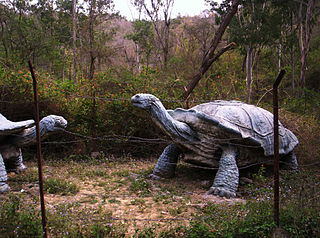Suketi Fossil Park
Nahan Renuka Road, Jamta, Nahan, Himachal Pradesh 173001

Shivalik Fossil Park, also known as the Suketi Fossil Park ,located at a distance of 22 kms from Nahan , is a fossil park with a collection of prehistoric vertebrate fossils and skeletons recovered from the upper and middle Siwaliks geological formations of sandstones and clay at Suketi in the Sirmaur district in the Indian state of Himachal Pradesh. The park has a display of the fossil finds and also an open-air exhibition of six extinct mammals formed in life-size models made of fiberglass, in a natural ambiance of the Sivalik Hills environment of the Plio-Pleistocene era (circa 2.5 million years) from where the fossils were unearthed. There is also a museum, within the precincts of the Suketi Fossil Park, where the fossils are curated and exhibited. It is Asia’s biggest fossil park. The exhibits in the park are used for generating scientific interest in the public and for facilitating special international studies by visiting research scholars from all over the world, apart from tourism development.
Location
The Suketi Fossil Park is named after the Suketi village where it is located, at the site where the fossils were found, in the Markanda River valley, at the foot of the Himalayas. It is at a distance of 22 kilometres (14 mi) southwest of Nahan, the district headquarters of Sirmaur district. Kala Amb, a small industrial town, is 5 kilometres (3.1 mi) away on the Kala Amb-Bikramabad road. The park, extensively forested, is spread out over an area of 1.5 square kilometres (0.58 sq mi) at Suketi. A tourism information desk is maintained at the park.
Features
The fiberglass models on display in an open area, outside the museum are of six extinct animals.They are: Huge land tortoise, gharial, four–horned giraffe, sabre-toothed cat, large tusked elephant, and hippopotamus.
The Saketi Park has a unique feature, in a miniature form, of the prehistoric biological record of the Upper Siwalik rocks, similar to those found in the Patwar Plateau and adjacent hills, also in Mangla dam areas in the region.
Models
The model of the sabre-tooth cat, almost similar to the present day species, is depicted with very long upper canine teeth, used to tear its prey. This animal became extinct about a million years ago; at the same time many species of elephants also became extinct. The hippopotamus model, made life-size similar to its present-day counterpart, has six incisors with a comparatively larger mouth but with a small brain hole, longer lower jaw and legs like the pig. This species, which existed in large numbers about 2.5 million years ago, is now extinct. The model of the giant land tortoise, representing a species found in the Shivalik region, is the largest of all tortoises but its present-day counterpart is much smaller. Models of the giant-sized elephants are of those which roamed 7 to 1.5 million years ago here, had a smaller cranium (bone portion of the skull), unusually long pair of tusks and huge limbs; these species numbering 15 vanished about 1.5 million years ago. The model of a four-horned giraffe, an ancestor of the present species, lived in the region 7 to 1.5 million years ago; it has an unusually large skull but a comparatively short neck. The models were initially within the park, however after the fire in jungle, few of the models were damaged and now the remaining ones are placed outside the museum.
Museum
The exhibits in the museum contain skeletal remains of different groups of skulls and limbs of mammals, skulls of hippopotamuses, tortoises, gharials and crocodiles, tusks of 22 species of elephants, rocks and charts and paintings related to the several aspects of plant and animal life of the past and present. The stone items on display belong to the Early Palaeolithic Man. Also preserved in the museum are fossils of two genera of extinct primates, Sivapithecus and Ramapithecus. The museum also houses antiquities unearthed by Captain Cautley in the area, from which he dug out the remains of Asia’s oldest human ancestor.
Exhibits also include an Indian postage stamp with images of two elephants and tusks, issued in 1951 on the occasion of the centenary of the Geological Survey of India.
Source : Wikipedia
Reviews
Visiting hours : 09.30AM to 05.00PM Closed on Tuesdays


Rate this article